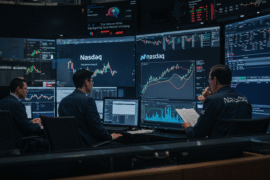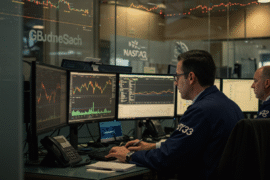This article may contain references to products or services from one or more of our advertisers or partners. We may receive compensation when you click on links to those products or services. Nonetheless, our opinions are our own.
Diversifying your investments is crucial in today’s volatile economic climate. It offers a hedge against inflation and minimizes the risk of losses. While the threat of a recession may not be as prominent as it was a year ago, it still makes sense not to put all your eggs in one basket. And spreading your investments across different traditional asset classes isn’t enough.
Alternative asset classes, which exhibit low correlations to stocks and bonds, are a must-have for diversification. In fact, 80% of young high-net-worth investors are choosing alternative assets over traditional financial instruments. It’s because 75% of these individuals don’t expect above-average returns solely from stocks and bonds.
When it comes to alternative investments, blue-chip art offers a few unique benefits over other emerging asset classes like cryptocurrency and NFTs. Plus, with mobile-friendly investment platforms like Masterworks, anyone with a few hundred dollars can add masterpieces by Banksy, Picasso, Warhol, and the like to their investment portfolio.
In this article, we’ll take a closer look at how Masterworks makes it possible for ordinary people to invest in fine art. But let’s first understand what makes art a clever choice for diversification.
Building a Diversified Portfolio With Fine Art
Blue-chip art – paintings by world-renowned artists that consistently command valuations in the hundreds of thousands or more – is known to have low correlations to traditional asset classes. For instance, in the first half of 2022, Sotheby’s witnessed record-breaking sales worth $4.3 billion. A single week in May accounted for nearly a quarter of these sales.
Keep in mind that during the same period, the world was grappling with macroeconomic challenges, including currency fluctuations and political uncertainties.
Similarly, in the first half of 2023, sales at major international auction houses exceeded the figures from the same period in 2019. By the end of 2023, a Picasso painting fetched an eye-popping $139 million, making it the second-most expensive piece by the artist ever sold.
These numbers reveal an interesting narrative – while traditional asset classes depreciate during periods of financial stress, fine art continues to hold strong. Be it the struggles of the Great Recession or economic decline due to the COVID-19 pandemic, the high-end art market has stayed afloat.
It’s understandable, considering that economic forces like interest rates and inflation don’t impact the value of blue-chip art. Instead, its value is determined by the artist’s reputation, the painting’s historical significance, and overall aesthetic appeal.
None of these factors depend on global economic conditions, and that’s precisely what makes fine art the right fit for a diversified portfolio.
But does blue-chip art offer any benefits over other alternative asset classes? Let’s take the example of cryptocurrency. Remember how Bitcoin’s value plummeted in 2021 after Elon Musk tweeted that Tesla had stopped accepting the cryptocurrency? Well, such price fluctuations are rare in the high-end art market.
Similarly, the limited supply of paintings by acclaimed artists puts fine art ahead of NFTs, which can be replicated. It’s easy to flood the internet with copies of the Cool Cats collection, affecting its value. On the other hand, original works by Picasso are impossible to recreate, which, in turn, drives their price.
Fine art’s price stability, combined with its low vulnerability to economic forces, make it a must-have for diversification.
The Barriers to Fine Art Investing
Despite their benefits, fine art investments have been restricted to ultra-wealthy investors. You need millions of dollars and a thorough understanding of the art market before you can lay your hands on museum-worthy pieces.
Besides purchasing a painting, you also have to factor in other expenses like appraisal, storage, and transportation. Ordinary investors like you and me don’t have access to that kind of funds. Many also find the process of identifying the right artist markets complex and intimidating.
Then, there’s the challenge of turning your fine art investments into cash. From setting the right resale price to finding a buyer whose tastes align with yours, reselling fine art can be cumbersome. It isn’t surprising that most investors perceive it as an illiquid asset class.
And that’s where a platform like Masterworks steps into the picture.
How Masterworks Makes High-Value Art Accessible and Investible
Launched in 2017, Masterworks lets you invest in museum-caliber paintings at a starting price of $20. The platform follows a fractional ownership model, meaning you can buy shares of multi-million dollar paintings instead of purchasing them outright.
Acquisition and private sales specialists at Masterworks use historical art transaction data to identify artist markets with the maximum potential for appreciation. After purchasing a painting, they securitize it with the SEC by filing an offering circular. Masterworks sets up a limited liability company dedicated to each painting, thereby opening up opportunities for fractional investing.
Once a painting is securitized, you can purchase fractional shares for as low as $20. That, in turn, makes blue-chip art accessible to regular investors with limited funds.
Also, with such low starting prices, you can further diversify your investments within Masterworks. Instead of restricting your options to a specific high-value painting or renowned artist, you can invest in the works of different artists. It safeguards your assets against losses due to shifting demand and supply trends in the art market.
It’s also worth noting that with Masterworks, you’re never responsible for storing or reselling the actual painting. The company retains each piece for three to ten years before selling it and distributing the profits to shareholders. With 16 successful exits to date, Masterworks has paid out 45% average annualized returns.
But what if you don’t want to wait for years to see returns? You can sell your shares in the Masterworks platform’s secondary market. Peer-to-peer trading offers an easy and quick way to convert your assets into cash.
Maximize the Benefits of a Diversified Portfolio With Masterworks
Among available alternative asset classes, fine art is an excellent fit for a diversified investment portfolio that stands the test of time. Masterworks’s fractional investing model offers an affordable and flexible way to invest in fine art without locking in millions of dollars for years.
With a community of over 880,000 members, Masterworks has acquired 392 paintings worth more than $941 million. The platform demystifies fine art investments and allows retail investors to break into the highly exclusive and elite world. And if you tread wisely, you can enjoy steady returns.
However, as with any alternative investment, keep in mind that past performance isn’t always a promise of future success. Build a foundation of traditional assets like stocks, bonds, and mutual funds before trying your hands at blue-chip art investing.

Reviewed and edited by Albert Fang.
See a typo or want to suggest an edit/revision to the content? Use the contact us form to provide feedback.
At FangWallet, we value editorial integrity and open collaboration in curating quality content for readers to enjoy. Much appreciated for the assist.
Did you like our article and find it insightful? We encourage sharing the article link with family and friends to benefit as well - better yet, sharing on social media. Thank you for the support! 🍉
Article Title: Fine Art’s Place in a Diversified Portfolio and How Masterworks Simplifies the Process
https://fangwallet.com/2024/01/20/fine-arts-place-in-a-diversified-portfolio-and-how-masterworks-simplifies-the-process/The FangWallet Promise
FangWallet is an editorially independent resource - founded on breaking down challenging financial concepts for anyone to understand since 2014. While we adhere to editorial integrity, note that this post may contain references to products from our partners.
The FangWallet promise is always to have your best interest in mind and be transparent and honest about the financial picture.
Become an Insider

Subscribe to get a free daily budget planner printable to help get your money on track!
Make passive money the right way. No spam.
Editorial Disclaimer: The editorial content on this page is not provided by any of the companies mentioned. The opinions expressed here are the author's alone.
The content of this website is for informational purposes only and does not represent investment advice, or an offer or solicitation to buy or sell any security, investment, or product. Investors are encouraged to do their own due diligence, and, if necessary, consult professional advising before making any investment decisions. Investing involves a high degree of risk, and financial losses may occur including the potential loss of principal.
Source Citation References:
+ Inspo












































